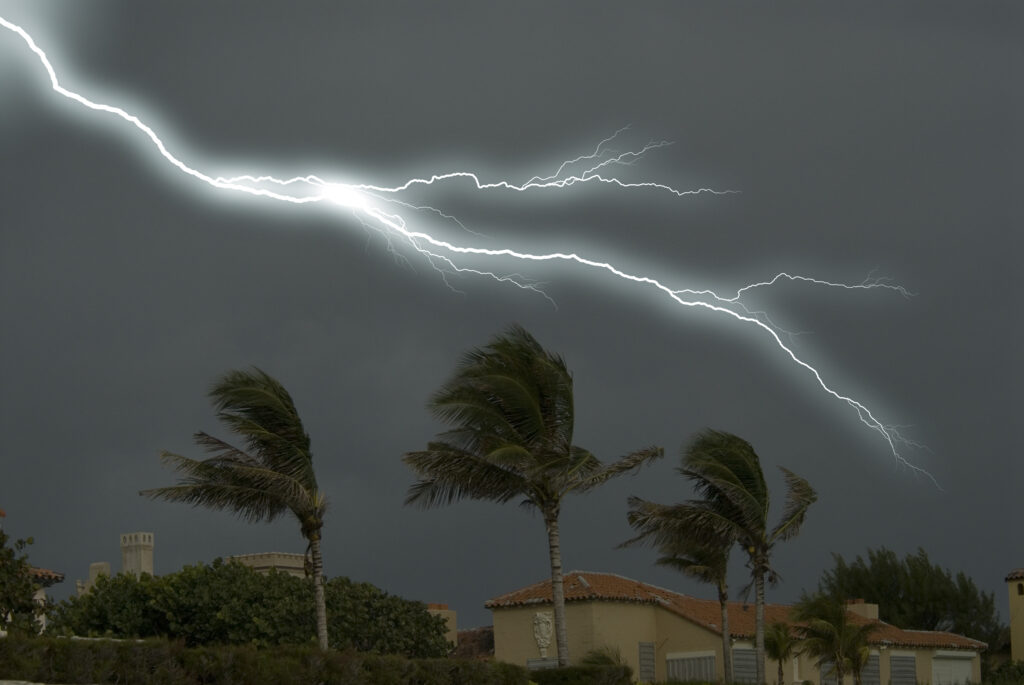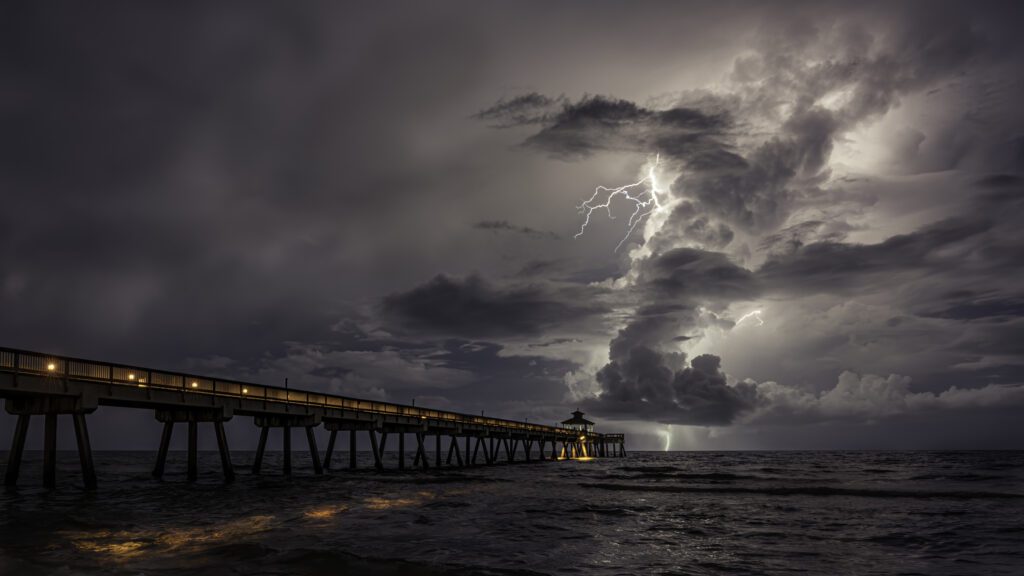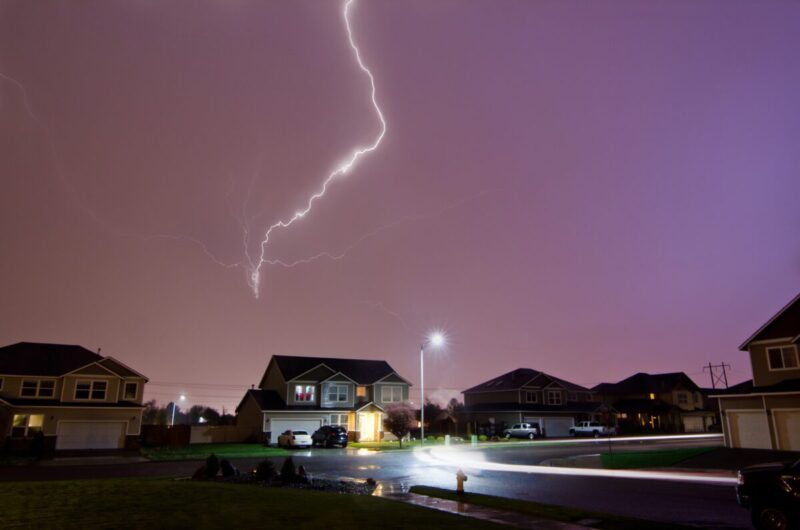In a flash, lightning can hurt you, damage your property and possessions or set your home on fire. But there’s a silver lining: a little knowledge and planning can help keep you safe during a storm.
Each year, about 100,000 thunderstorms hit the United States. Since thunder is the sound caused by lightning, all of those storms come with lightning. “Lightning is a giant spark of electricity that occurs either in a cloud or between a cloud and the ground,” says John Jensenius, a lightning safety specialist for the National Weather Service (NWS). What causes lightning? During a storm, electrical charges accumulate in a cloud, which causes opposite electrical charges to accumulate on the ground beneath the cloud. “Lightning is a way of equalizing those charges,” he explains.
If you’re in the wrong place at the wrong time, those sudden electrical discharges can be very dangerous. Although 90% of those struck by lightning live, many victims are left with permanent injuries. A lightning strike can cause bad burns, hearing loss, long-term disabilities and severe emotional problems, says Richard Kithil, CEO & Founder of the National Lightning Safety Institute. “It’s a traumatic experience.” And unfortunately, not everyone makes it; already in 2024, 9 people have been killed from lightning ranging from the age of 7 to 73.
Where & When Does Lightning Strike?
Thunderstorms happen more often in some parts of the country and during certain months of the year than others.
Based on data from the National Oceanic and Atmospheric Administration (NOAA), the South experiences thunderstorms more frequently than the other regions, partly due to its proximity to the Gulf of Mexico. And Florida, in particular, seems to be a breeding ground for lightning.
Thunderstorms are more frequent in the summer than at other times of the year due to the humidity and warmth; thunderclouds—those electrically charged clouds that produce lightning—are formed when moist, warm air from the Earth’s surface reaches the upper atmosphere and cools. Thus, summer is the most dangerous time of the year in regard to lightning strikes, but it’s equally as important to stay diligent in late spring and early fall.
Prepping Your Home
It’s important to ready your home for severe weather of all sorts. This is especially true in regard to thunderstorms. In addition to lightning, they can bring fire, floods, hail, strong winds and tornadoes, according to Ready.gov. To prep your home, start by:
- creating a disaster plan.
- practicing tree maintenance, like removing trees or branches that could damage your property if they fell.
- repairing damaged building components, such as loose gutters and roof shingles.
These steps should be taken well before a thunderstorm is forecasted.
If you want to take extra measures to shield your home from lightning damage, consider installing a lightning protection system, recommends Kim Loehr, spokeswoman for the Lightning Protection Institute, an organization dedicated to improving lightning protection. A complete system grounds the home and provides surge protection. Some homes, especially smart homes, are built with these systems in place, but a homeowner can have a professional install.
It’s smart to be prepared because lightning is one of the most common weather perils, says Loehr, and it can be very dangerous. “Lightning can pack up to 100 million volts of power, sometimes more.”
In addition to taking steps to prepare your home, it’s always a good idea to know what’s covered by your homeowners insurance and car insurance policies, before a severe weather event strikes. For example, your home policy won’t cover flood damage, so if you’re concerned about rainwaters from a storm damaging your home, you’ll need to purchase a separate flood insurance policy ahead of time.

Warning Signs
It’s a good idea to check the weather each morning to see whether thunderstorms are in the forecast. If you can, especially if you live in an area prone to sudden thunderstorms, Jensenius recommends that you download a weather radar app for your smartphone and try to plan outings around the storms. Should a thunderstorm strikes while you’re away, and open upstairs window could lead to wind damage in your home’s interior, so make sure to close all windows and doors whenever you leave your home.
Keeping an eye on the sky can also help you stay safe from lightning. When you’re outdoors, pay attention to signs that signal a storm might be brewing: a sudden darkening of the sky in the middle of the day, the appearance of billowing clouds or even the faintest sound of thunder in the distance, he says.
The NWS has a safety slogan: “When thunder roars, go indoors,” says Jensenius. And, he adds: “It doesn’t even have to be a roar—it can be a rumble or a crackle.”
Seeking Shelter
The great outdoors is the most dangerous place to be when lightning strikes. “There simply is no safe place outside in a thunderstorm,” asserts Jensenius.
So far, all 2024 lightning victims were struck outdoors, whether they were in a park, at the beach or right outside their home.
If you have outdoor activities planned, make sure you can quickly reach either a car or a sturdy, enclosed building—not a pavilion or other open structure.
What’s the most important lightning safety fact to remember? Take shelter at the very first sign of a storm. “Many people wait too long,” says Jensenius. Lighting can strike 10 miles in front of and behind a storm. “When you hear a distant rumble, you’re already in some danger of being struck,” he adds.
And, contrary to popular belief, seeking shelter under a tree to stay dry in a storm is not an effective shelter from lightning. Being underneath a tree is the second leading cause of lightning casualties, so seek shelter indoors if possible.

Driving Safely
What if you’re behind the wheel when a storm rolls in? If you’re driving a hard-topped car, it should be safe to remain in the car, but you should pull to the side of the road to wait out the storm.
If lightning were to strike your car, you’d probably see a blinding flash and hear a loud boom. It’s possible that the strike could blow out a tire and could damage the electrical system in your car, says Jensenius. But, you would probably be okay. “Cars being more or less metal boxes, the people inside them are very safe in the event of a direct strike,” says Kithil.
A word of caution: some of the lightning’s current can flow through the vehicle’s electric or metal components. Therefore, once you’ve pull over, turned on your hazard lights and turned off your engine, try to keep your hands in your laps until the storm passes.
Weathering the (Thunder) Storm at Home
Home is one of the safest places to stay during a thunderstorm, but you should still take some precautions to protect yourself from lightning.
“You want to stay away from anything that could conduct electricity to you,” recommends Jensenius. Don’t use anything that plugs directly into the wall, including corded phones, and stay away from the plumbing, which can conduct electricity. Also, avoid touching windows and doors, he warns, adding that a metal doorknob could conduct electricity from the outside to you.
If your home is struck, you’ll probably hear a loud noise and maybe see some damage to your home, such as appliances that suddenly stop working.
Watch for smoke, as that could indicate the lightning sparked a fire, urges Jensenius. And consider having your local fire department check your home with a thermal imaging camera because a small fire could smolder in the walls for a few hours before growing into a blaze, he says.
If you’ve waited out the storm indoors, don’t rush outside as soon as you think the danger has passed. To be on the safe side, wait at least 30 minutes after the last sign of lightning or thunder before going out. “There are people who get struck going out after a storm,” warns Jensenius.
How do you prepare for lightning? Let us know in the comments!







I wasn’t aware a person should wait at least 30 minutes after a storm before going outside.
Thank you for the reminders to stay safe.
Glad you mentioned that being in a car is usually safe (as is an airplane).
But the speed of lightning is 186,000 miles per SECOND (not per hour).
Side note: The thunderclap from the lightning only travels at the speed of sound. Count the delay in seconds, then divide by 5 to get an estimate of the distance to the lightning strike.
Good reminders
I SURIVED A LIGHTNING STRIKE TO MY HOUSE, TAMPA BAY AREA. WHEN IT HIT MY AMATURE RADIO ANTENNA, THEN WENT ACROSS FROM SOUTH TO NORTH AND KILLED EVERYTHING ELECTRIC! THE STRIKE LEFT THRU THE END OF HOUSE, BLOWING A 12″ HOLE THRU CEMENT BLOCK WALL!!